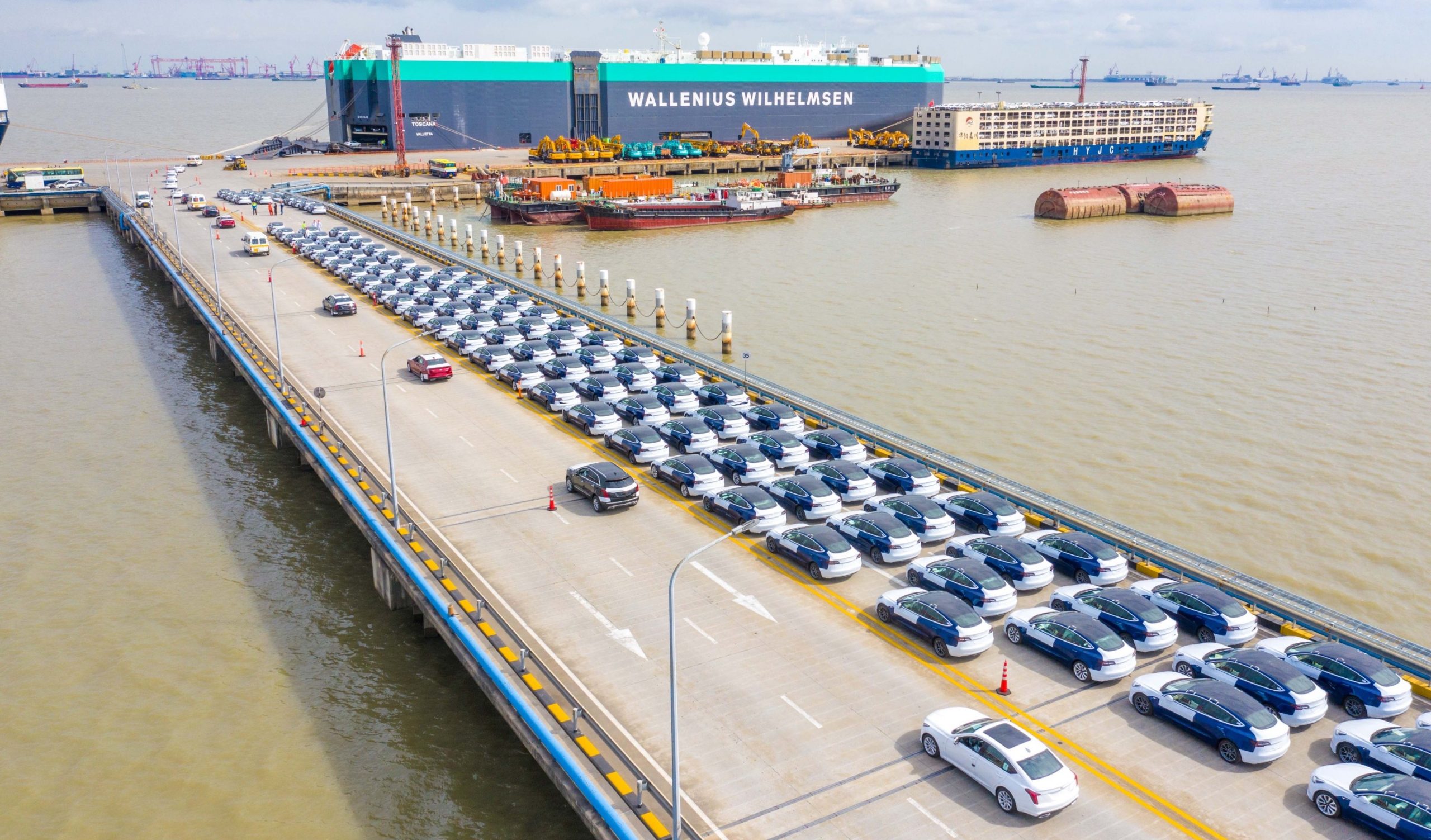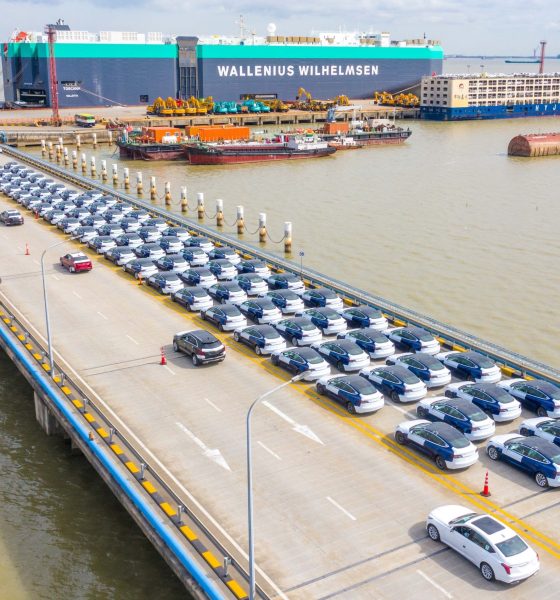

News
Tesla Giga Shanghai’s Model 3 production run-rate already hitting 91% of ambitious 2021 targets
Tesla Giga Shanghai produced 22,292 Model 3 vehicles in the month of October, according to vehicle production data from the Chinese Passenger Car Association (CPCA). Tesla’s production numbers came in second in the country after SAIC-GM-Wuling (SGMW), which manufactured 29,843 units of its Mini EV micro electric car. BYD’s production numbers came in third with 22,268 units.
Tesla industry watcher @TroyTeslike noted that Gigafactory Shanghai produced 22,929 Model 3s in October. He calculated that the electric car maker achieved an annual run-rate of 275,148 vehicles per year at its current production pace. However, Tesla’s lightning-fast Shanghai factory is not known for maintaining the status quo. Not long ago Wall Street estimated that Tesla’s Shanghai plant would only produce 35,000 to 40,000 in its first year of operations.
Considering that Model 3 production is already at a run-rate of 275,000 vehicles per year in Giga Shanghai, it would appear that Tesla China is already at ~91% of its ambitious 2021 manufacturing target. Tesla China aims to manufacture 550,000 vehicles next year, 300,000 of which will be Model 3s. To reach its 2021 Model 3 production goals, Giga Shanghai would need to produce around 25,000 units of the all-electric sedan per month. That’s just a bit over 2,000 compared to Tesla’s October 2020 production figures.
Based on October’s numbers, Tesla China could reach its target 2021 Model 3 run rate by the end of the year, provided that it continues to steadily increase its production capabilities in the coming weeks. This may happen since the company is currently looking to deliver over 180,000 vehicles in the fourth quarter.
Once Giga Shanghai has reached its Model 3 production goals for next year, it can concentrate on its targets for the Model Y. Tesla China wants to hit the ground running by making 250,000 Model Y units in 2021. The Made-in-China Model Y was registered with the Chinese Ministry of Industry & Information Technology recently. Giga Shanghai just needs to wait for a permit to produce Tesla’s crossover. Sightings of the Made-in-China Tesla Model Y have been reported in China in recent weeks as well.
Just recently, the Chinese Passenger Car Association (CPCA) revealed that Tesla sold 12,143 Made-in-China Model 3s in October, translating to a 7.18% month-over-month growth compared to the previous month. In September, the EV automaker had sold 11,238 Model 3s in China. This may seem like a conservative improvement, but it should be noted that Tesla also exported 7,000 Model 3s to Europe in October.
The CPCA expects Giga Shanghai’s Model 3 sales to significantly increase in November and December, as mentioned by Tesla owner-investor @Ray4Tesla. Shanghai’s new regulations, which limits out-of-city vehicles within its major roads, could increase demand for the locally-made sedan. Giga Shanghai is also poised to export more Model 3s to Europe in the coming weeks, which could result in higher sales numbers from Tesla China in Q4.

News
Tesla (TSLA) receives “Buy” rating and $551 PT from Canaccord Genuity
He also maintained a “Buy” rating for TSLA stock over the company’s improving long-term outlook, which is driven by autonomy and robotics.

Canaccord Genuity analyst George Gianarikas raised his Tesla (NASDAQ:TSLA) price target from $482 to $551. He also maintained a “Buy” rating for TSLA stock over the company’s improving long-term outlook, which is driven by autonomy and robotics.
The analyst’s updated note
Gianarikas lowered his 4Q25 delivery estimates but pointed to several positive factors in the Tesla story. He noted that EV adoption in emerging markets is gaining pace, and progress in FSD and the Robotaxi rollout in 2026 represent major upside drivers. Further progress in the Optimus program next year could also add more momentum for the electric vehicle maker.
“Overall, yes, 4Q25 delivery expectations are being revised lower. However, the reset in the US EV market is laying the groundwork for a more durable and attractive long-term demand environment.
“At the same time, EV penetration in emerging markets is accelerating, reinforcing Tesla’s potential multi‑year growth runway beyond the US. Global progress in FSD and the anticipated rollout of a larger robotaxi fleet in 2026 are increasingly important components of the Tesla equity story and could provide sentiment tailwinds,” the analyst wrote.
Tesla’s busy 2026
The upcoming year would be a busy one for Tesla, considering the company’s plans and targets. The autonomous two-seat Cybercab has been confirmed to start production sometime in Q2 2026, as per Elon Musk during the 2025 Annual Shareholder Meeting.
Apart from this, Tesla is also expected to unveil the next-generation Roadster on April 1, 2026. Tesla is also expected to start high-volume production of the Tesla Semi in Nevada next year.
Apart from vehicle launches, Tesla has expressed its intentions to significantly ramp the rollout of FSD to several regions worldwide, such as Europe. Plans are also underway to launch more Robotaxi networks in several more key areas across the United States.
News
Waymo sues Santa Monica over order to halt overnight charging sessions
In its complaint, Waymo argued that its self-driving cars’ operations do not constitute a public nuisance, and compliance with the city’s order would cause the company irreparable harm.

Waymo has filed a lawsuit against the City of Santa Monica in Los Angeles County Superior Court, seeking to block an order that requires the company to cease overnight charging at two facilities.
In its complaint, Waymo argued that its self-driving cars’ operations do not constitute a public nuisance, and compliance with the city’s order would cause the company irreparable harm.
Nuisance claims
As noted in a report from the Los Angeles Times, Waymo’s two charging sites at Euclid Street and Broadway have operated for about a year, supporting the company’s growing fleet with round-the-clock activity. Unfortunately, this has also resulted in residents in the area reportedly being unable to sleep due to incessant beeping from self-driving taxis that are moving in and out of the charging stations around the clock.
Frustrated residents have protested against the Waymos by blocking the vehicles’ paths, placing cones, and “stacking” cars to create backups. This has also resulted in multiple calls to the police.
Last month, the city issued an order to Waymo and its charging partner, Voltera, to cease overnight operations at the charging locations, stating that the self-driving vehicles’ activities at night were a public nuisance. A December 15 meeting yielded no agreement on mitigations like software rerouting. Waymo proposed changes, but the city reportedly insisted that nothing would satisfy the irate residents.
“We are disappointed that the City has chosen an adversarial path over a collaborative one. The City’s position has been to insist that no actions taken or proposed by Waymo would satisfy the complaining neighbors and therefore must be deemed insufficient,” a Waymo spokesperson stated.
Waymo pushes back
In its legal complaint, Waymo stated that its “activities at the Broadway Facilities do not constitute a public nuisance.” The company also noted that it “faces imminent and irreparable harm to its operations, employees, and customers” from the city’s order. The suit also stated that the city was fully aware that the Voltera charging sites would be operating around the clock to support Waymo’s self-driving taxis.
The company highlighted over one million trips in Santa Monica since launch, with more than 50,000 rides starting or ending there in November alone. Waymo also criticized the city for adopting a contentious strategy against businesses.
“The City of Santa Monica’s recent actions are inconsistent with its stated goal of attracting investment. At a time when the City faces a serious fiscal crisis, officials are choosing to obstruct properly permitted investment rather than fostering a ‘ready for business’ environment,” Waymo stated.
News
Tesla FSD v14.2.2 is getting rave reviews from drivers
So far, early testers have reported buttery-smooth drives with confident performance, even at night or on twisty roads.

Tesla Full Self-Driving (Supervised) v14.2.2 is receiving positive reviews from owners, with several drivers praising the build’s lack of hesitation during lane changes and its smoother decision-making, among others.
The update, which started rolling out on Monday, also adds features like dynamic arrival pin adjustment. So far, early testers have reported buttery-smooth drives with confident performance, even at night or on twisty roads.
Owners highlight major improvements
Longtime Tesla owner and FSD user @BLKMDL3 shared a detailed 10-hour impression of FSD v14.2.2, noting that the system exhibited “zero lane change hesitation” and “extremely refined” lane choices. He praised Mad Max mode’s performance, stellar parking in locations including ticket dispensers, and impressive canyon runs even in dark conditions.
Fellow FSD user Dan Burkland reported an hour of FSD v14.2.2’s nighttime driving with “zero hesitations” and “buttery smooth” confidence reminiscent of Robotaxi rides in areas such as Austin, Texas. Veteran FSD user Whole Mars Catalog also demonstrated voice navigation via Grok, while Tesla owner Devin Olsen completed a nearly two-hour drive with FSD v14.2.2 in heavy traffic and rain with strong performance.
Closer to unsupervised
FSD has been receiving rave reviews, even from Tesla’s competitors. Xpeng CEO He Xiaopeng, for one, offered fresh praise for FSD v14.2 after visiting Silicon Valley. Following extended test drives of Tesla vehicles running the latest FSD software, He stated that the system has made major strides, reinforcing his view that Tesla’s approach to autonomy is indeed the proper path towards autonomy.
According to He, Tesla’s FSD has evolved from a smooth Level 2 advanced driver assistance system into what he described as a “near-Level 4” experience in terms of capabilities. While acknowledging that areas of improvement are still present, the Xpeng CEO stated that FSD’s current iteration significantly surpasses last year’s capabilities. He also reiterated his belief that Tesla’s strategy of using the same autonomous software and hardware architecture across private vehicles and robotaxis is the right long-term approach, as it would allow users to bypass intermediate autonomy stages and move closer to Level 4 functionality.








